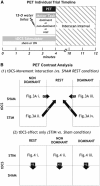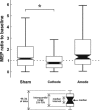Bilateral transcranial direct current stimulation modulates activation-induced regional blood flow changes during voluntary movement
- PMID: 21559029
- PMCID: PMC3208154
- DOI: 10.1038/jcbfm.2011.72
Bilateral transcranial direct current stimulation modulates activation-induced regional blood flow changes during voluntary movement
Abstract
Transcranial direct current stimulation (tDCS) is a noninvasive brain stimulation technique that induces changes in cortical excitability: anodal stimulation increases while cathodal stimulation reduces excitability. Imaging studies performed after unilateral stimulation have shown conflicting results regarding the effects of tDCS on surrogate markers of neuronal activity. The aim of this study was to directly measure these effects on activation-induced changes in regional cerebral blood flow (ΔrCBF) using positron emission tomography (PET) during bilateral tDCS. Nine healthy subjects underwent repeated rCBF measurements with (15)O-water and PET during a simple motor task while receiving tDCS or sham stimulation over the primary motor cortex (M1). Motor evoked potentials (MEPs) were also assessed before and after real and sham stimulation. During tDCS with active movement, ΔrCBF in M1 was significantly lower on the cathodal than the anodal side when compared with sham stimulation. This decrease in ΔrCBF was accompanied by a decrease in MEP amplitude on the cathodal side. No effect was observed on resting or activated rCBF relative to sham stimulation. We thus conclude that it is the interaction of cathodal tDCS with activation-induced ΔrCBF rather than the effect on resting or activated rCBF itself which constitutes the physiological imaging correlate of tDCS.
Figures





References
-
- Baudewig J, Nitsche MA, Paulus W, Frahm J. Regional modulation of BOLD MRI responses to human sensorimotor activation by transcranial direct current stimulation. Magn Reson Med. 2001;45:196–201. - PubMed
-
- Boggio PS, Castro LO, Savagim EA, Braite R, Cruz VC, Rocha RR, Rigonatti SP, Silva MT, Fregni F. Enhancement of non-dominant hand motor function by anodal transcranial direct current stimulation. Neurosci Lett. 2006;404:232–236. - PubMed
Publication types
MeSH terms
Grants and funding
LinkOut - more resources
Full Text Sources

